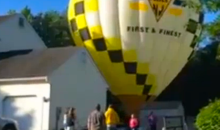Infrasound balloons to detect distant explosions
Geophysicists at Sandia National Laboratories in Albuquerque, New Mexico, have designed a hot air balloon that could play a role in national defense by detecting low-frequency sounds.
By looking at it you might not think anything of it. In fact, it only takes about $50 to make. However, this solar-powered hot air balloon can monitor for explosions like those created in underground nuclear testing facilities.
“I think when you watch movies about science or you think about scientists, you think we like complex thing or complicated things with bells and whistles. In reality, we want the simplest possible system and this is about as simple as it gets,” said Danny Bowman, a geophysicist.
Painter’s plastic, packing tape, some string, and a little charcoal dust which helps the balloon fly and make up the deceiving piece of technology. Attached to it are reusable infrasound sensors and GPS tracker.
For Bowman, this breakthrough science started as a hobby back in 2012.
After years of trial and error, they were finally able to do their first operational flight in 2016, where they recorded an explosion nearly 200 miles away.
Now, Bowman and his partner, Sarah Albert, are proposing flying the balloons as a part of the National Nuclear Security Administration’s next project. The goal of the project is to improve the nation’s capability to detect and characterize underground nuclear explosions and to be able to monitor low-yield nuclear testing.
“When you fly multiple balloons and have this 3D pattern in the sky, you’re able to actually locate it. Now we can pick up the signal and say it probably occurred in this region,” said Albert.
Bowman and Albert also hope to fly hot air balloons in space. Their goal is to send them to Venus and Jupiter to listen to quakes.
Bowman is also encouraging high school and college students to build one of these balloons. He’s challenging students to try to beat their record of flying 80,000 feet.
-via KRQE News 13




